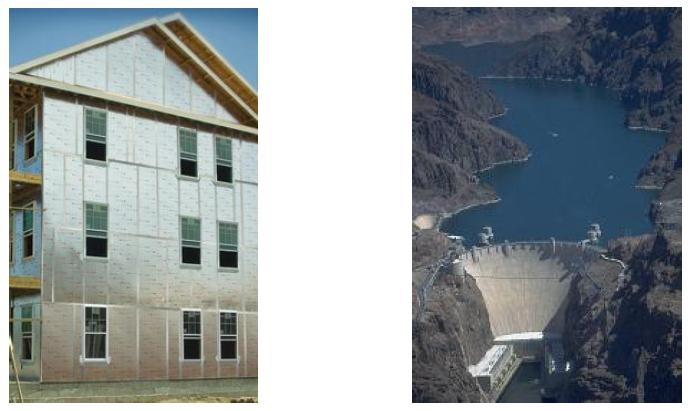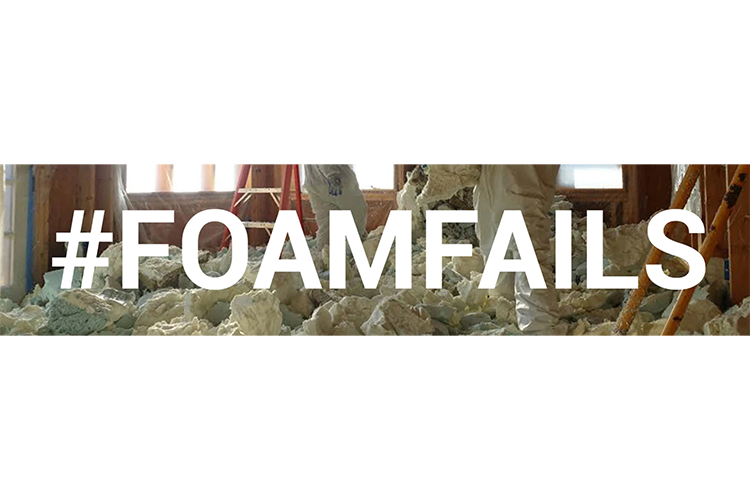Counterproductive Vapor Retarder
As insulation levels increase, building enclosures get colder and are more resistant to drying out - staying wetter longer, and posing greater risks for mold and structural damage. With the structure unable to "bake/air" dry in the old energy inefficient manner, the assembly drying capacity - its resiliency - becomes reliant on vapor diffusion-driven drying.
 On left: a warm inefficient enclosure that "bakes dry".
On left: a warm inefficient enclosure that "bakes dry".
On right: a cold and well insulated enclosure dependent on vapor diffusion drying. (photo credit: Passive House Institute, Darmstadt, Germany)
Therefore we want to maximize the assembly's vapor diffusion drying potential.
Water vapor naturally diffuses through materials from areas of high concentration to low concentration, and from warmer temperatures to cooler temperatures. In cold and mixed climates (Climate Zones 4 and up), the dominant vapor drive is from the warm/humid interior to the cold/dry exterior - outward. If there is moisture in the assembly, it wants to get out to the exterior. And so generally, it makes good sense to let it - by having vapor open materials outboard.
But a not-so-funny thing happened on the way to the forum. Like the energy industry's obsession with fossil fuels and nuclear power, the construction industry fell in love with foam (and vapor retarding wood sheathings).

Foam industry advertisment
Let's take a quick look at the evolution of wood frame construction in this regard. Below in diagram (A) we see wood framing with vapor open pine board sheathing outboard, wood framing with little to no insulation, and interior plaster: uncomfortable, inefficient and safe from moisture damage. In diagram (B) we have the introduction of batt insulation in the framing cavity to provide greater comfort and energy efficiency, along with vapor retarding plywood or OSB sheathing replacing the pine boards outboard. The insulation makes the assembly colder - moving the dew point into the cavity - while the interior surface of the vapor retarding outboard sheathing becomes the first condensing surface - potentially resulting in moisture damage. In diagram (C) we have the introduction of outboard continuous insulation to raise the temperature of the vapor retarding sheathing to above the dew point, avoiding condensation and related damage. And soon - as if by the magic of misleading insulating values (see Reason Foam Fails #3) - nearly all the wrapping is done with foam insulation that further retards the assembly's ability to dry outward.

As we wrap our buildings in vapor retarding sheathing and foam it is important to note their moisture damming capabilities. The vapor permeability of foam varies from Class 1 vapor retarders: 0.0 perms for foil faced polyiso, to 0.5 perms for 2" thick XPS. EPS permeability varies but is approximately: 1" = 3.5 perms, 2" = 1.75 perms, 3" = 0.875 perms, 4" = 0.5 perms etc... The OSB and plywood sheathings in dry bulb conditions are Class 3 vapor retarder at 1 perm.
 Left: Vapor closed foil-faced polyiso. Right: The Hoover Dam
Left: Vapor closed foil-faced polyiso. Right: The Hoover Dam
The vapor wants to go out and the sheathing and foam are damming it, raising the humidity and moisture levels - decreasing resilience.
To illustrate this phenomenon we placed the same above three wall assemblies in Boston Mass, and analyzed them in WUFI Pro. The graphs below are based on readings taken in the wall sheathing. The walls are facing north and have no rain contributed moisture, nor does it have any new construction pre-loaded moisture.
Wall Assembly A: classic framed wall without insulation
First is our classic framed wall without insulation, wall A. The humidity levels rise and fall following the seasons but never get much above 72% relative humidity. (Note: The humidity level is important in relation to temperature. If the humidity is at 80% or above over a 30 day average temperature of 50 degrees Fahrenheit mold growth can kick-in and so the DANGER lights should be going off.) Wall Assembly A: Historic framed wall with no insulation, board sheathing and siding outboard with plaster inboard.
Wall Assembly A: Historic framed wall with no insulation, board sheathing and siding outboard with plaster inboard.
Humidity levels don't reach 80%. Safe and inefficient.
Wall Assembly B: 2x6 framed wall with plywood or OSB sheathing and batt insulation
The next assembly, B, shown below - has extended periods with 100% humidity and condensation forming at the inside face of the sheathing. This is not good. This is bad. Avoid this assembly.
 B) 2x6 framed wall with plywood or OSB sheathing and batt insulation. An assembly called trouble
B) 2x6 framed wall with plywood or OSB sheathing and batt insulation. An assembly called trouble
Wall Assembly C: wrapped in 2" of XPS foam board insulation
Next we have wall C, then wrapped in 2" of XPS foam board insulation. While there is no condensation forming (a very good thing), the moisture levels are elevated, and mold risk is increased as the assembly lacks any tolerance to added moisture, on the borderline of failure. It is not a robust nor resilient profile.
 Wall Assembly C: Now add 2" of XPS outboard to avoid condensation, yet resulting in a dangerous dose of wetness.
Wall Assembly C: Now add 2" of XPS outboard to avoid condensation, yet resulting in a dangerous dose of wetness.
And if you're wondering, 1" of XPS is worse, as it isn't enough to prevent condensation. If you wish to remain stuck in this foam cul-de-sac, the only "answer" is to add ever greater amounts of foam outboard. Because of this, foam is a counterproductive vapor retarder and the fourth reason foam fails.
Wall Assembly D: a more resilient foam-free alternative
We can do better: more resilient, more robust, more ecological. To see alternatives to wrapping your building in foam see our five drawing set DWG files available in our Building Assembly Guides section.
To see a comparable WUFI model of an assembly that has a robust and resilient vapor profile, below we show a wall that is 2x6 wall framing with batt insulation and plywood sheathing outboard - wall D. But rather than wrapping the sheathing in foam, we wrap it in fibrous insulation outboard and provide a smart vapor retarder inboard. The humidity levels stay below 72% and have tolerance for the unexpected.A more resilient approach.
 Wall Assembly D: a more resilient foam-free alternative: 2" fibrous insulation outboard, sheathing, 2x6 with batts and an inboard smart vapor retarder.
Wall Assembly D: a more resilient foam-free alternative: 2" fibrous insulation outboard, sheathing, 2x6 with batts and an inboard smart vapor retarder.
And the alternative sketch diagram below.
 Wall D: smart vapor retarder inboard and fibrous insulation outboard make this a safer and more resilient alternative.
Wall D: smart vapor retarder inboard and fibrous insulation outboard make this a safer and more resilient alternative.



